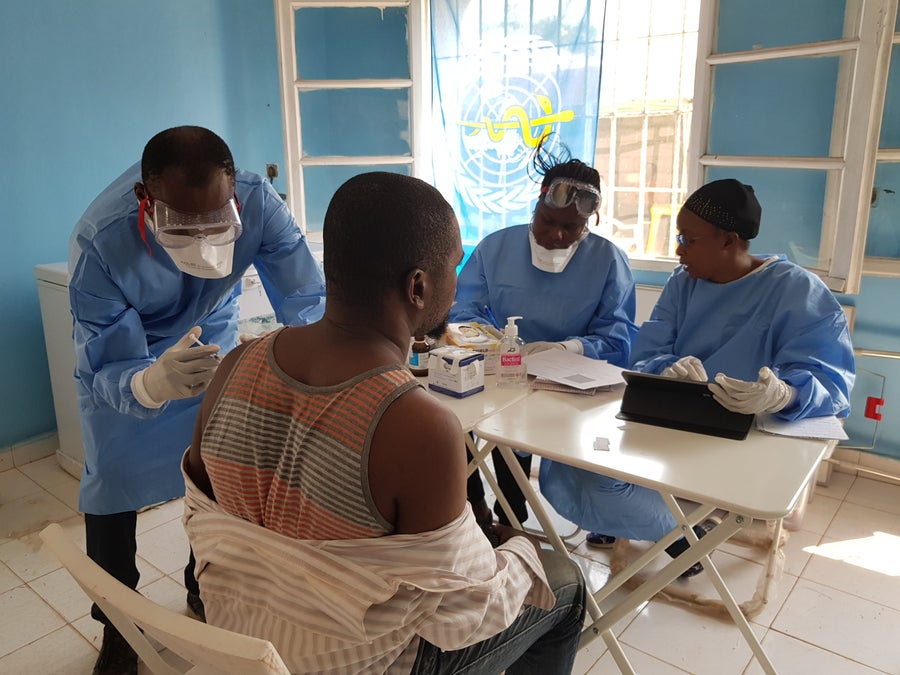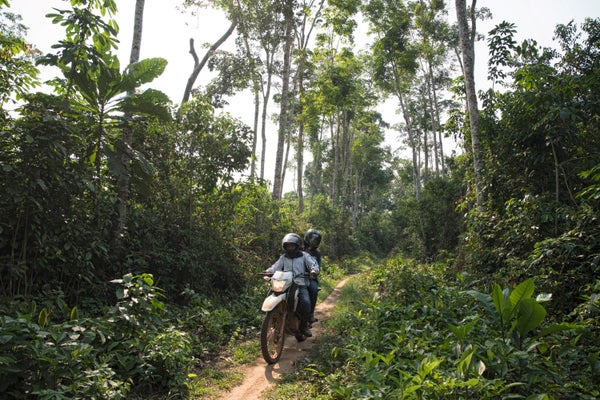When Ebola flared up in the Democratic Republic of the Congo last month, a wave of international public health workers had just left the country, where they had been deployed to combat cholera. But less than two weeks after leaving, some were rushing back to help with the new crisis.
Alhassane Touré was among them. As the physician who quickly became the coordinator of the World Health Organization’s efforts to roll out an experimental anti-Ebola inoculation in the DRC, he was needed on the ground. At home in Guinea, he had headed up a very successful Ebola vaccine effort three years earlier, helping to deploy an experimental shot after the west African crisis had already gripped the region. But this time around, his team had access not just to the experimental vaccine, but also to financial support that would allow them to offer the inoculation near the start of an Ebola outbreak—and try to contain it relatively early.
Touré also has other advantages. “Here the people are already informed about how [the vaccine] was used in west Africa,” he says. In addition, 37 of his colleagues are also from Guinea and had helped to organize and administer vaccinations there during the prior outbreak. And during another, smaller Ebola outbreak in the DRC a year ago, DRC government officials had already started talking with the WHO and others about procedures for offering the Ebola vaccine, if necessary, during an outbreak.
On supporting science journalism
If you're enjoying this article, consider supporting our award-winning journalism by subscribing. By purchasing a subscription you are helping to ensure the future of impactful stories about the discoveries and ideas shaping our world today.
As a result, about a month after the first Ebola shots were given to people in the DRC, Touré is feeling cautiously optimistic about their successes across the three locations that reported cases: two rural areas in Équateur province called Iboko and Bikoro, and Mbandaka, a city of 1.2 million. The country’s last confirmed Ebola case was on June 6, according to the WHO’s figures on June 21. With the help of DRC community health workers who fostered acceptance of the vaccine—developed by New Jersey–based pharmaceutical giant Merck—Touré’s team has vaccinated 1,611, including 574 frontline health workers. Doctors Without Borders has also been offering the shot, and in total more than 3,000 vaccines have been administered in the country.

Alhassane Touré administers an Ebola vaccine to help contain the outbreak in the Democratic Republic of the Congo. Credit: Saya Oka The World Health Organization
“Now in Mbandaka there haven’t been cases in many weeks, so the [WHO] team is now just in Iboko and Bikoro, and maybe we’ll be there for a week or more until we get more information,” Touré says. “If there are no new lab-confirmed cases in those places, we will just start to have the rest of the frontline workers and the team come to Mbandaka to wait until our reports are all finished.” Five experimental Ebola drugs designed to treat already ill patients were not even used during this outbreak because by the time an international working group and DRC authorities had approved them for use in the DRC and sent the drugs, there were no new cases, notes Daniel Bausch, a veteran Ebola responder and director of the U.K. Public Health Rapid Support Team.
Public health workers say they are far from declaring the outbreak over; that pronouncement typically comes one day after two 21-day incubation periods pass with no new cases. Such a count begins after the confirmed recovery of the last ill patient or after the last Ebola-related burial. The most recent burial was on June 10, the WHO says, but the official count has not yet started because the organization is not sure that was the last case. Ebola responders know a single missed case could reignite the chain of transmission, so they must remain vigilant for anyone with possible symptoms and check on the contacts of known Ebola patients. For now, case numbers remain relatively stable. There have been more than 60 probable or confirmed cases and 28 deaths.
With much of the focus now on careful surveillance, Touré’s team is grappling with the difficulties of continuing to monitor the vaccinated individuals for the three-week period following their shots—a key requirement for the team’s real-time study on the experimental Merck vaccine. On three separate occasions—on or close to days 3, 14 and 21 after vaccination—health workers must meet with the inoculated person, ask questions about the individual’s health status and check for a fever. But people are not always reachable in person or by phone. The electricity and cell phone coverage have been spottier than when the team worked in Guinea, Touré says. This has made communication and coordination incredibly difficult. There are other obstacles, too: the difficulty of reaching people in remote areas on difficult roads that are sometimes muddy and the need to tamp down the rumors and distrust that often plague responses to major outbreaks.
That means health care workers must return to remote sites again and again, traversing bad roads via motorbike or car for a face-to-face check-in. If they do not find the vaccinated person, team members keep trying for 30 days before they give up and note in their official records that the person was lost to follow-up, Touré explains.
Selecting whom to vaccinate in the first place hinges on reports from community health workers, the DRC’s Ministry of Public Healthand other involved parties. The WHO and Doctors Without Borders are vaccinating people who are either direct contacts of Ebola patients or “contacts of contacts”—a rough categorization typically determined by geographic proximity. For example, it includes neighbors, extended family members and people who live with high-risk contacts.
Finding all those people can be difficult in DRC communities. Many do not have cell phones, and health workers’ records may not include the correct addresses or even accurate spellings of names. People may also move or travel, which makes them difficult to track, says Jonathan Polonsky, a WHO epidemiologist and one of the coordinators of surveillance activities and contact tracing at Mbandaka.
One day, Polonsky says, his team received a list of 25 names of direct contacts of probable or confirmed Ebola cases whom community health workers had been unable to track down—so the list had been escalated to specialists like him. “We were going on very little. We didn’t have an address in some cases, or sometimes we didn’t even know the general area,” he says.
It turned out, however, that through sheer persistence some of those people were relatively easy to find: “In one case the person just lived across the road from the address we had down,” he says. After spending about an hour and a half going from street to street looking for one individual on the list based on his name and the fact that he was a doctor, Polonsky explains, the team was able to find him only after finally realizing his name had been spelled incorrectly. Some of the missing 25—fewer than 10—have not been found, out of roughly 300 people that Polonsky’s team was tasked with locating in Mbandaka, he says. Even with the Ebola case numbers remaining steady in recent weeks, those are the people he continues to worry about.
Last weekend, after five weeks in the DRC, Polonsky was sent home to rest. Yet even now, he says he still thinks about those missing people and wonders if they could be out there sick—or perhaps making others sick. “It’s frustrating,” he says. “It’s always a nagging thought.”
